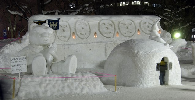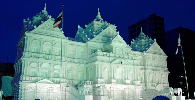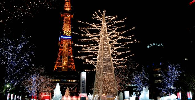Program & Abstracts
- Dates: February 10-14
- Places: the lecture hall (Feb 10-13) and the first meeting room (Feb 14)
- (Both rooms are located on the first floor of the Conference Hall. Internet access is not available in the Coference Hall.)
February 10
| 9:30-9:40 |
Opening
|
|---|---|
| 9:40-10:20 |
What do biological and production networks have in common?
D. Armbruster (Arizona State University Tempe, USA) |
| 10:20-11:00 |
Modelling of experience dependent behavior – Fighting among male crickets
H. Aonuma (RIES, Hokkaido University) |
| 11:00-11:30 |
Coffee Break
|
| 11:30-12:10 |
A Mathematical Model of Amoeboid Locomotion
R. Kobayashi (Hiroshima University) |
| 12:10-12:50 |
Large scale movement on spatial networks: from the global cargo shipping network to bird migration
B. Blasius (University of Oldenburg, Germany) |
| 12:50-14:00 |
Lunch
|
| 14:00-14:40 |
Generalized models: Analyzing the dynamics of diagramatic representations of complex heterogeneous networks
Th. Gross (Max-Planck Institute for Physics of Complex Systems, Germany) |
|---|---|
| 14:40-15:20 |
A step toward understanding the principle of biological networks
Y. Suzuki (Graduate School of Nagoya Univ.) |
| 15:20-15:50 |
Coffee Break
|
| 15:50-16:30 |
Mathematical Model for the Foraging Tactics of Ants Colony under Unsteady Food Supply
H. Nishimori (Hiroshima University) |
| 16:30-17:10 |
Towards Synthesis of Mammalian Circadian Clocks
H. Ueda (RIKEN, Osaka University) |
| 17:10-17:30 |
Coffee Break
|
| 17:30-18:10 |
Oblique collisions in dissipative systems
Y. Nishiura (RIES, Hokkaido University) |
| 19:00- |
Welcome Party (Aspen Hotel)
|
February 11
| 9:30-10:10 |
Evolutionary engineering of complex functional networks
A. S. Mikhailov (Fritz Haber Institute of the Max Planck Society, Germany) |
|---|---|
| 10:10-10:50 |
Network evolution of body plans: a modeling approach for evolutionary developmental biology
K. Fujimoto (Osaka University) |
| 10:50-11:10 |
Coffee Break
|
| 11:10-11:50 |
Synchronization effects in transportation networks with biologically inspired self-organized control
R. Donner (Dresden University of Technology, Germany) |
| 11:50-12:30 |
Jamology - Research on jams of self-driven particles
K. Nishinari (University of Tokyo) |
| 12:30- |
Lunch and Excursion
|
February 12
| 9:30-10:10 |
Consistency Principe for Robust Biological Systems
K. Kaneko (University of Tokyo) |
|---|---|
| 10:10-10:50 |
The logistics of metabolism
M.-Th. Hütt (Jacobs University, Germany) |
| 10:50-11:20 |
Coffee Break
|
| 11:20-12:00 |
Control of hybrid systems: a new framework for control of complex systems
J. Imura (Tokyo Institute of Technology) |
| 12:00-12:30 |
Round table discussion session
|
| 12:30-14:00 |
Lunch
|
February 12
| 14:00-14:10 |
Opening
|
|---|---|
| 14:10-14:50 |
Collective molecular motor using chiral liquid crystalline thin films
H. Yokoyama (National Institute of Advanced Industrial Science and Technology) |
| 14:50-15:30 |
Self-propelled particles with nematic interactions: From simple agent-based models to experiments with rod-shaped bacteria
M. Bär (Physikalisch-Technische Bundesanstalt, Germany) |
| 15:30-16:00 |
Coffee Break
|
| 16:00-17:00 |
Short Presentation of Posters
|
| 17:00-20:30 |
Poster Session + Banquet (Banquet starts at 18:30)
|
February 13
| 9:30-10:10 |
Splashes by a frog diving into water
O. Mochizuki (Toyo Univerisity) |
|---|---|
| 10:10-10:50 |
Integrated study of insect flight: from aerodynamics, maneuverability to optimization
H. Liu (Chiba University) |
| 10:50-11:10 |
Coffee Break
|
| 11:10-11:50 |
Fluid dynamics of a suspension of micro-organisms
T. Ishikawa (Tohoku University) |
| 11:50-12:30 |
Theory of flapping flight using vortices
M. Iima (RIES, Hokkaido University) |
| 12:30-14:00 |
Lunch
|
| 14:00-14:40 |
Single molecule nanoscience: Fluctuation and function of life
T. Yanagida (Osaka University) |
|---|---|
| 14:40-15:20 |
Coordination of Cell Shape and Motility in Spontaneous Cell Migration
M. Sano (University of Tokyo) |
| 15:20-15:50 |
Coffee Break
|
| 15:50-16:30 |
Dissipative patterns in heterogeneous BZ systems
V. K. Vanag (Brandeis University, USA) |
| 16:30-17:10 |
Deformable self-propelled particles
T. Ohta (Kyoto University) |
| 17:10-17:30 |
Coffee Break
|
| 17:30-18:10 |
Hypotheses on the functional roles of chaotic transitory dynamics
I. Tsuda (RIES, Hokkaido University) |
February 14
| 9:30-10:10 |
Synchronization of a circadian clock in vitro
H. Ito (Ochanomizu Uiversity) |
|---|---|
| 10:10-10:50 |
Nonequilibrium Phase Transition to Synchronization in Small World Networks of Phase Oscillators
R. Tönjes (Ochanomizu Uiversity) |
| 10:50-11:10 |
Coffee Break
|
| 11:10-11:50 |
Individual vs. Collective Descriptions of Coupled Oscillators
Y. Kuramoto (Kyoto University) |
| 11:50-12:10 |
Linking cell-level and system-level responses in oscillator networks with any network structure
H. Kori (Ochanomizu University) |
| 12:10-12:40 |
Round table discussion and closing
|
February 12
17:00-20:30 (Banquet starts at 18:30)
| P01 |
Spiral wave propagation on the excitable Kuramoto lattice
Edgar Avalos, Pik-Yin Lai, Chi-Keung Chan |
|---|---|
| P02 |
Effect of coupling strength on frequency enhancement in excitable medium : Application to Cultured Cardiac Myocyte Synchronization
Wei-Yin Chiang, Pik-Yin Lai, C. K. Chan |
| P03 |
Predicting the distribution of spiral waves from cell properties in a model of Dictyostelium pattern formation
Daniel Geberth |
| P04 |
Controlling of Excitable Waves in Heart Tissue: Two Different Approaches
Marcel Hörning |
| P05 |
Behavior of multi adaptive reaction system and environment-dependent response
Masayo Inoue |
| P06 |
Full Synchronization and Partial Synchronization of a Multi-country Inventory Cycle Model
Kenichi Ishiyama |
| P07 |
Perturbation of BZ patterns by amphipliles
Rumana Akther Jahan, Kosuke Suzuki, Hitoshi Mahara, Tomohiko Yamaguchi |
| P08 |
Method to control dynamics of coupled oscillators using multi-linear feedback
Takeshi Kano |
| P09 |
On the intermittency phenomena in the shell-model turbulence
Miki Kobayashi |
| P10 |
Design principle of multi-cluster and desynchronized states in oscillatory media
Yasuaki Kobayashi |
| P11 |
Dynamical response of oscillator networks: linking cell-level and system-level responses
Hiroshi Kori |
| P12 |
The total regulation of gene expression by DNA- membrane complexes formation
Vasily V. Kuvichkin |
| P13 |
Multiscale Networks of Interacting Biological Systems: From network constructions to causality among them
Chun Biu Li |
| P14 |
Self-sustained Oscillation in a Non-oscillatory Cell Chain and Its Bifurcation Analysis
Ma Yue |
| P15 |
The relation between thermodynamic indices and pattern formation
Hitoshi Mahara |
| P16 |
Freezing transition of unidirectional lattice-gas flow of flexible chainlike objects
Takashi Mashiko, Yasuhito Imanishi, Ryota Kuwajima, Takashi Nagatani |
| P17 |
Distribution of residence time at quasi-stationary states in globally coupled map
Akira Masumi, Tomoyuki Yamamoto, Takashi Hashimoto |
| P18 |
Mathematical analysis on a continuum model for a flow of granular materials
Naoto Nakano |
| P19 |
Achievement of Emergent Alternative Configurations of Vehicle for Easing Traffic Congestion on Weaving Sections
Ryosuke Nishi, Hiroshi Miki, Akiyasu Tomoeda, Katsuhiro Nishinari |
| P20 |
Discreteness-induced pattern formation in nonlinear proliferation systems
Kenta Odagiri |
| P21 |
Memory, hysteresis and oscillation induced by multiple covalent modifications and its application to circadian rhythm of Cyanobacteria
Isamu Ohnishi |
| P22 |
Flexible biochemical switches based on mixed feedback loops
Benjamin Pfeuty |
| P23 |
Time Averaged Properties along Unstable Periodic Orbits in Some Systems of Differential Equations
Yoshitaka SAIKI |
| P24 |
Heteroclinic cycle and propagating pulse wave in a ring of coupled bistable oscillators
Kuniyasu Shimizu |
| P25 |
Pattern evolution on the surface of reactive oil droplets
Kosuke Suzuki, Tomohiko Yamaguchi |
| P26 |
Swarm Oscillators
Dan Tanaka |
| P27 |
Two-parameter bifurcations in the Hodgkin-Huxley equations for muscle
Kazuko Terada |
| P28 |
Folding patterns of stable/unstable manifolds in high dimensional dynamical systems
Hiroshi Teramoto |
| P29 |
Spatiotemporal Pattern Formation in the Molecular Machinery in Biological Systems
Yuichi Togashi |
| P30 |
Perturbation Analysis of Anisotropic Traffic Flow Model
Akiyasu Tomoeda, Daisuke Shamoto, Ryosuke Nishi, Kazumichi Otsuka, Katsuhiro Nishinari |
| P31 |
Position control of target pattern by annulus illumination on Belousov-Zhabotinsky reaction
Toshihiro Tsuzuki |
| P32 |
Front interactions in a three component system
Peter van Heijster |
| P33 |
Self-Organized Pattern Formation of Bacteria Colony
Joe Yuichiro Wakano |
| P34 |
Periodic solution of the cylinder wake
Takeshi Watanabe |
| P35 |
Nonlocal Comlex Ginzburg-Landau equation as a model of single Dictyostelium discoideum cell
Miki M. Yamamoto |
| P36 |
Adaptive locomotion to friction change in one-dimensional modular robot
Tetsuya Yamamoto |
| P37 |
Effect of Conflicts and Turning on Pedestrian Outflow through an Exit
Daichi Yanagisawa, Ayako Kimura, Akiyasu Tomoeda, Ryosuke Nishi, Yushi Suma, Kazumichi Ohtsuka, Katsuhiro Nishinari |
| P38 |
Spot Dynamics of Reaction-diffusion system in Heterogeneous Media
Xiaohui Yuan, Takashi Teramoto, Yasumasa Nishiura |




 PROGRAM [64KB]
PROGRAM [64KB] HOME
HOME